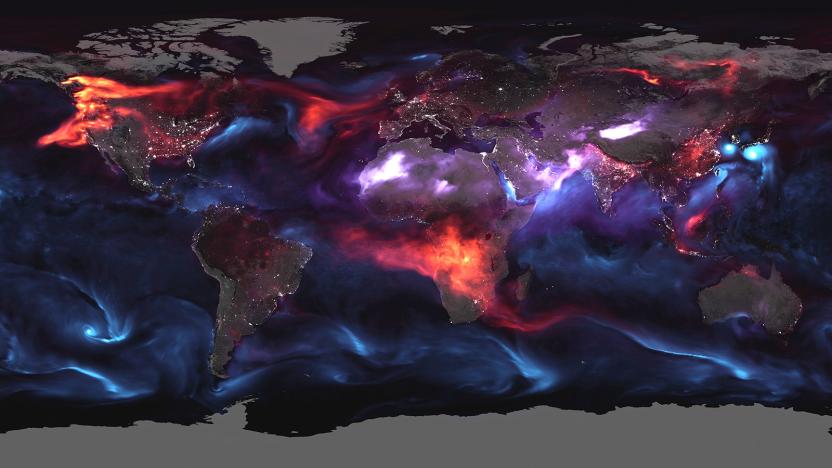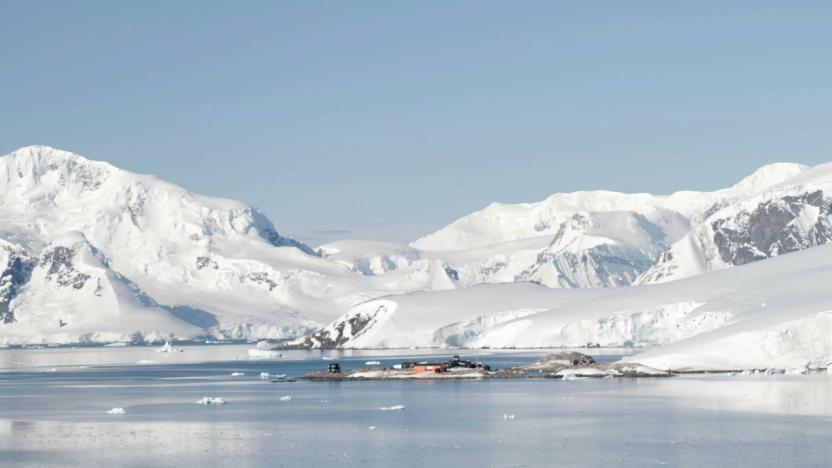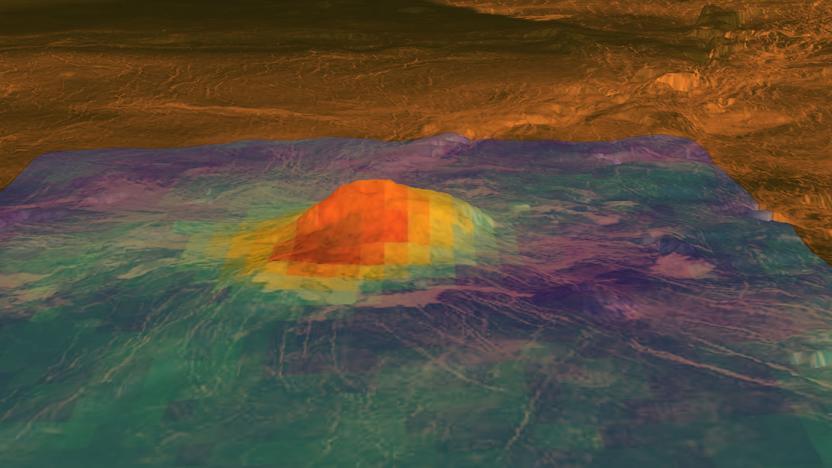Volcanoes
Latest

NASA's terrifying visualization of atmospheric aerosols
Heatwaves, hurricanes and other extreme weather might be the "face of climate change," but it's not the only sign. A grim new visualization from NASA shows another problem caused indirectly by global warming: airborne particles and droplets. These "aerosols," shown on a single day on August 23rd, come from dust, volcanic ash and other sources. They're particularly brutal this year because of fires in California, British Columbia and the southern part of Africa.

Study finds massive volcano range hidden in Antarctica's ice
A new study claims to have found a huge expanse of volcanoes lurking beneath the ice in Antarctica. Scientists unearthed a total of 91 previously undiscovered volcanoes -- some stretching up to 3,850 metres (12,600 feet) in height -- in the region known as the West Antarctic Rift System (WARS). The area is comparable to the densely concentrated volcanic regions in east Africa and North America, according to researchers from the University of Edinburgh.

Venus might still have active volcanoes
We already know that Venus has more volcanoes than any other planet in our solar system. What we're still not sure of is whether those volcanoes are still active -- now a new study suggests that at least one of them exploded quite recently. A team of scientists led by Piero D'Incecco from the German Aerospace Center in Cologne took a closer look at Idunn Mons, a massive volcano on the planet that's around 120 miles in diameter. To put that into perspective, Mauna Loa, known as the largest active volcano on Earth, is only 75 miles across.

ICYMI: NASA hunts for life hidden in an asteroid
try{document.getElementById("aol-cms-player-1").style.display="none";}catch(e){}Today on In Case You Missed It: NASA is planning a trip to get a sample of the large asteroid Bennu and see if any organic materials can be found on it. If you remember hypercolor t-shirts, you'll want to know about an air pollution sensing shirt that changes color and patterns when carbon monoxide, radioactivity and particle pollutants are detected. You'll want to see this video from Japan showing a volcano's eruption with a thunderstorm inside. As always, please share any interesting tech or science videos you find by using the #ICYMI hashtag on Twitter for @mskerryd.

Asteroid hit and volcanoes linked as suspects in dinosaur extinction
Ah majestic dinosaurs, your oversized bodies and tiny brains may have been doomed no matter what. But, that asteroid that wiped out all of the giant lizards may have had some volcanic help. According to a new paper published in Science, the Chicxulub impact may have accelerated volcanic activity and helped to release toxic gas from a massive (200,000 square miles massive) lava lake in India known as the Deccan Traps. The researchers point out that the impact didn't cause the geologic activity (like the sea of melted metal) but it's likely that it intensified the situation. That one-two punch of asteroid impact and volcanoes could be the reason why 66 million years ago 70 percent of species on the planet were wiped out. Researchers stated that after the events it could have taken 500,000 years for the Earth's ecosystem to bounce back. The study could also reconcile the volcano versus asteroid extinction theory. Either way, pour out some Tricerahops for our fallen friends, the dinosaurs. [Image credit: Getty Images]

Sonar-mapping ship looks for baby lobsters, finds dead volcanoes
You never know what you might find when you're looking for lobster larvae. Iain Suthers, a marine biologist at the University of New South Wales, recently led a team of 28 scientists on board Australia's latest research vessel, Investigator. They set out to study nursery grounds of lobsters when they accidentally stumbled upon four ancient underwater volcanoes off the coast of Sydney. The massive cluster of craters, said to be about 50 million years old, stretches across 12 miles on the seafloor but had gone unnoticed until now.

Inhabitat's Week in Green: fly like a bird, bend batteries in half, and spray clothing from a can
Each week our friends at Inhabitat recap the week's most interesting green developments and clean tech news for us -- it's the Week in Green. This week saw several amazing feats of aeronautics as we showcased the world's first continuous flight of a human-powered ornithopter and the sun-powered Solar Impulse plane embarked upon an incredible voyage across Switzerland. We also watched transportation take off as BMW unveiled a zippy new electric scooter, Sanitov launched a GPS enabled cargo tricycle in London, and this week's Green Overdrive show took us off-roading on a souped-up e-bike! Renewable energy tech also energized the globe as several countries in Central America launched plans to tap volcanoes for power and China developed the world's first directly solar-powered air conditioning unit. Energy storage also got a big boost as Stanford researchers unveiled a new type of bendable battery made out of paper - just the thing to power the flexible e-readers of the future. In other news, this week we brought you exclusive coverage of the greatest green designs from this year's London Design Festival and we showcased the latest in wearable tech - instant spray-on clothing in a can! Finally, we tackled an issue that has plagued tech junkies forever - those impossible-to-open clamshell plastic packages.

Hawaiian volcano in sped up, thermal video: pretty intense
The United States Geological Survey's thermal camera recently captured some wild stuff over at the Kilauea volcanic caldera in Hawaii. The video (which is below) has been sped up four times, and shows a 450 foot-wide vent which is usually obscured by gas fumes.The results are impressive and overwhelming. Check it out.





